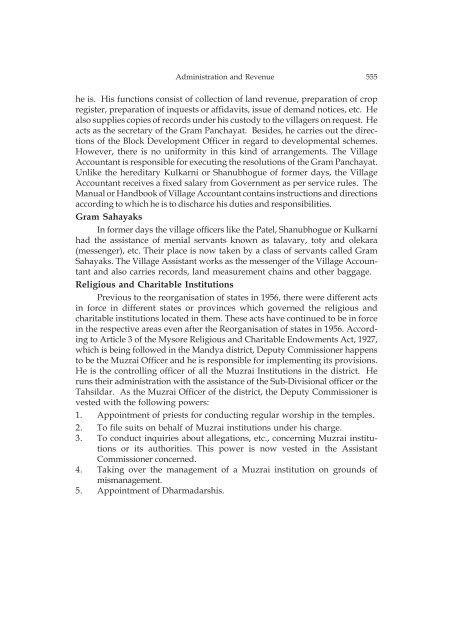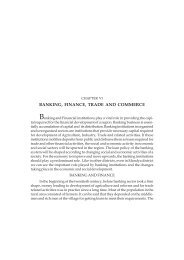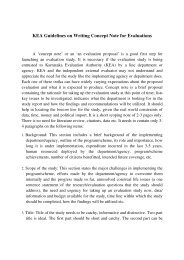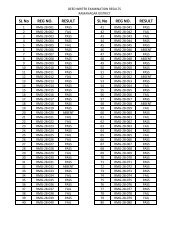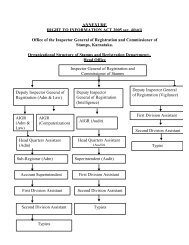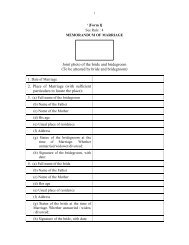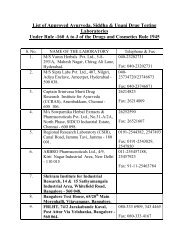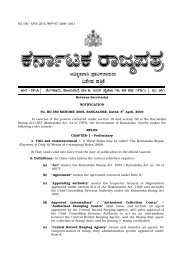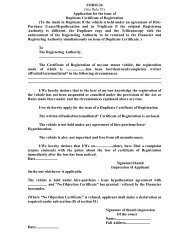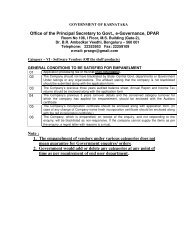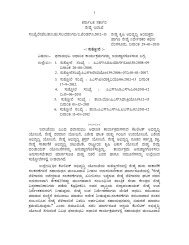Chapter-9 - Government of Karnataka
Chapter-9 - Government of Karnataka
Chapter-9 - Government of Karnataka
You also want an ePaper? Increase the reach of your titles
YUMPU automatically turns print PDFs into web optimized ePapers that Google loves.
Administration and Revenue 555he is. His functions consist <strong>of</strong> collection <strong>of</strong> land revenue, preparation <strong>of</strong> cropregister, preparation <strong>of</strong> inquests or affidavits, issue <strong>of</strong> demand notices, etc. Healso supplies copies <strong>of</strong> records under his custody to the villagers on request. Heacts as the secretary <strong>of</strong> the Gram Panchayat. Besides, he carries out the directions<strong>of</strong> the Block Development Officer in regard to developmental schemes.However, there is no uniformity in this kind <strong>of</strong> arrangements. The VillageAccountant is responsible for executing the resolutions <strong>of</strong> the Gram Panchayat.Unlike the hereditary Kulkarni or Shanubhogue <strong>of</strong> former days, the VillageAccountant receives a fixed salary from <strong>Government</strong> as per service rules. TheManual or Handbook <strong>of</strong> Village Accountant contains instructions and directionsaccording to which he is to discharce his duties and responsibilities.Gram SahayaksIn former days the village <strong>of</strong>ficers like the Patel, Shanubhogue or Kulkarnihad the assistance <strong>of</strong> menial servants known as talavary, toty and olekara(messenger), etc. Their place is now taken by a class <strong>of</strong> servants called GramSahayaks. The Village Assistant works as the messenger <strong>of</strong> the Village Accountantand also carries records, land measurement chains and other baggage.Religious and Charitable InstitutionsPrevious to the reorganisation <strong>of</strong> states in 1956, there were different actsin force in different states or provinces which governed the religious andcharitable institutions located in them. These acts have continued to be in forcein the respective areas even after the Reorganisation <strong>of</strong> states in 1956. Accordingto Article 3 <strong>of</strong> the Mysore Religious and Charitable Endowments Act, 1927,which is being followed in the Mandya district, Deputy Commissioner happensto be the Muzrai Officer and he is responsible for implementing its provisions.He is the controlling <strong>of</strong>ficer <strong>of</strong> all the Muzrai Institutions in the district. Heruns their administration with the assistance <strong>of</strong> the Sub-Divisional <strong>of</strong>ficer or theTahsildar. As the Muzrai Officer <strong>of</strong> the district, the Deputy Commissioner isvested with the following powers:1. Appointment <strong>of</strong> priests for conducting regular worship in the temples.2. To file suits on behalf <strong>of</strong> Muzrai institutions under his charge.3. To conduct inquiries about allegations, etc., concerning Muzrai institutionsor its authorities. This power is now vested in the AssistantCommissioner concerned.4. Taking over the management <strong>of</strong> a Muzrai institution on grounds <strong>of</strong>mismanagement.5. Appointment <strong>of</strong> Dharmadarshis.


